Developing strong stick control is essential for drummers to execute precise rhythms, articulate drum patterns, and express their musical ideas with clarity. By focusing on stick control exercises, drummers can enhance their technique, improve accuracy, and achieve greater versatility on the drum set. In this article, we will explore a range of drumming exercises specifically designed to improve stick control and develop dexterity, speed, and finesse.
- Single Stroke Roll Exercise: a. Start with a slow tempo and play a single stroke roll, alternating hands. b. Aim for even, consistent strokes with both hands. c. Gradually increase the tempo while maintaining control and accuracy. d. Focus on maintaining a relaxed grip and utilizing finger control for fluid and controlled strokes.
- Double Stroke Roll Exercise: a. Begin at a moderate tempo and play a double stroke roll, consisting of two strokes with each hand. b. Focus on maintaining even and consistent spacing between the two strokes. c. Gradually increase the tempo while maintaining control, accuracy, and consistency. d. Pay attention to stick height, rebound, and finger control for smooth and controlled execution.
- Paradiddle Exercise: a. Start at a comfortable tempo and play the paradiddle rudiment: RLRR LRLL. b. Focus on maintaining an even and consistent volume between the hand-to-hand transitions. c. Increase the tempo gradually while maintaining control and accuracy. d. Emphasize the accents and maintain a consistent rhythm throughout the exercise.
- Flam Exercise: a. Begin at a slow tempo and practice playing flams, which consist of a grace note followed by a primary stroke. b. Focus on achieving a clear distinction between the grace note and the primary stroke. c. Gradually increase the tempo while maintaining control and accuracy in the flam execution. d. Experiment with different dynamics, playing both soft and loud flams.
- Stick Control Patterns: a. Utilize stick control exercises from the book “Stick Control for the Snare Drummer” by George Lawrence Stone. b. Practice various patterns, such as eighth notes, sixteenth notes, and combinations of different note values. c. Focus on maintaining consistency in volume, spacing, and control between each stroke. d. Gradually increase the tempo while maintaining precision and accuracy in the patterns.
- Rhythmic Subdivision Exercises: a. Use a metronome and practice playing different rhythmic subdivisions, such as quarter notes, eighth notes, triplets, and sixteenth notes. b. Start at a slow tempo and focus on accurate and consistent execution of each subdivision. c. Gradually increase the tempo while maintaining control and precision. d. Experiment with different accents, dynamics, and subdivisions to develop versatility and control.
- Finger Control Exercises: a. Practice finger control exercises, such as finger rolls or finger-based strokes, on a practice pad. b. Focus on utilizing finger control for controlled and articulate strokes. c. Develop strength and dexterity in your fingers through regular practice of these exercises. d. Apply the finger control techniques to drumming patterns and rudiments on the drum set.
- Stickings Variations: a. Practice drumming patterns and rudiments using different stickings, such as paradiddles, flam accents, or double paradiddles. b. Focus on maintaining control, accuracy, and consistent volume with each sticking variation. c. Explore the musical possibilities and different sounds that can be achieved through various stickings. d. Experiment with different tempos and dynamics to enhance your control and versatility.
Conclusion: Improving stick control is a continual journey that requires dedicated practice and focus. By incorporating exercises such as the single stroke roll, double stroke roll, paradiddles, flams, stick control patterns, rhythmic subdivision exercises, finger control exercises, stickings variations, and more, drummers can enhance their technique, precision, and overall drumming proficiency. Remember to practice with a metronome, maintain a relaxed grip, and gradually increase the tempo as you progress. Regular and focused practice of these exercises will result in improved stick control, enabling you to execute complex patterns, articulate rhythms with clarity, and express your musical ideas with finesse and confidence.

